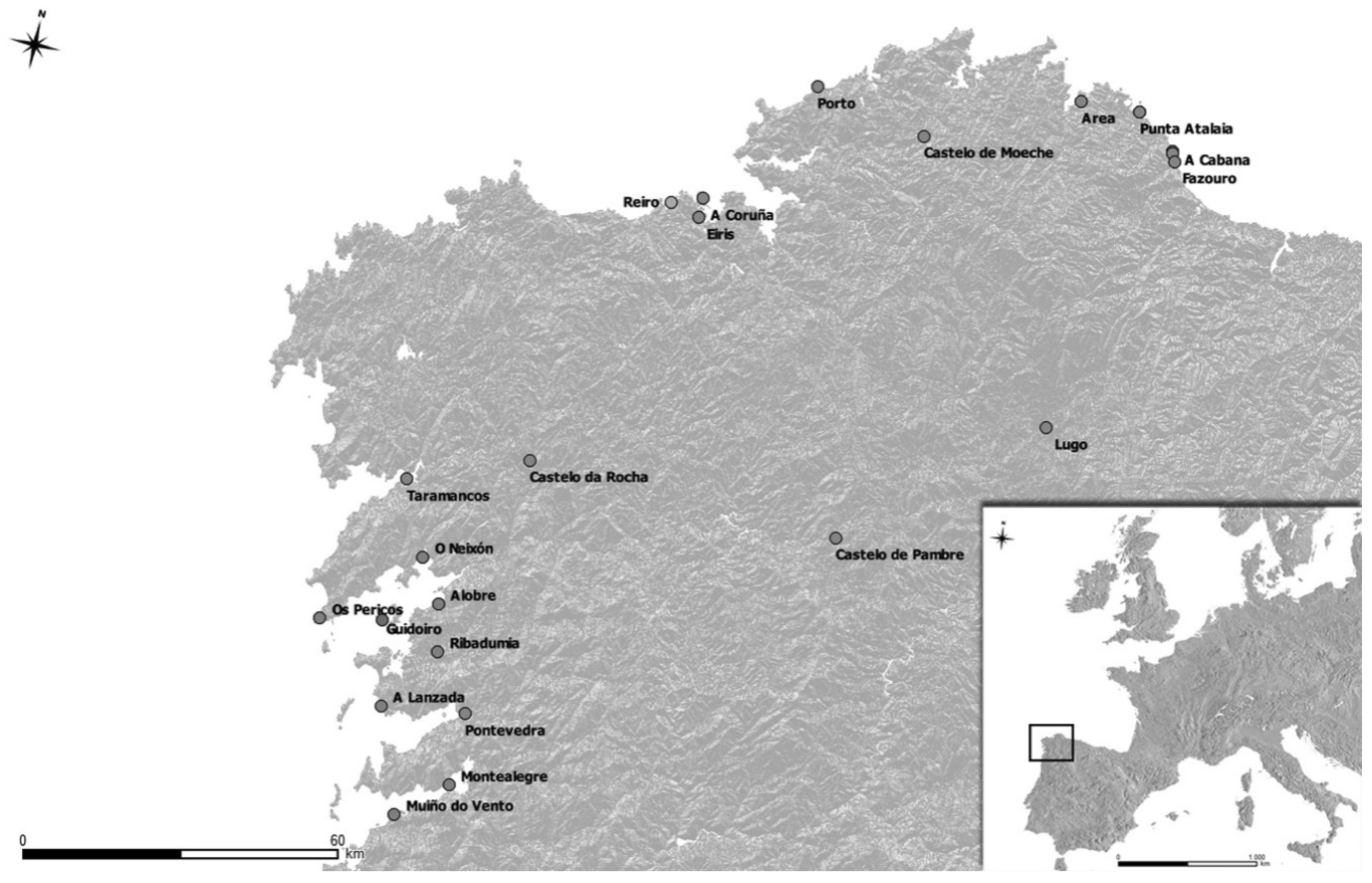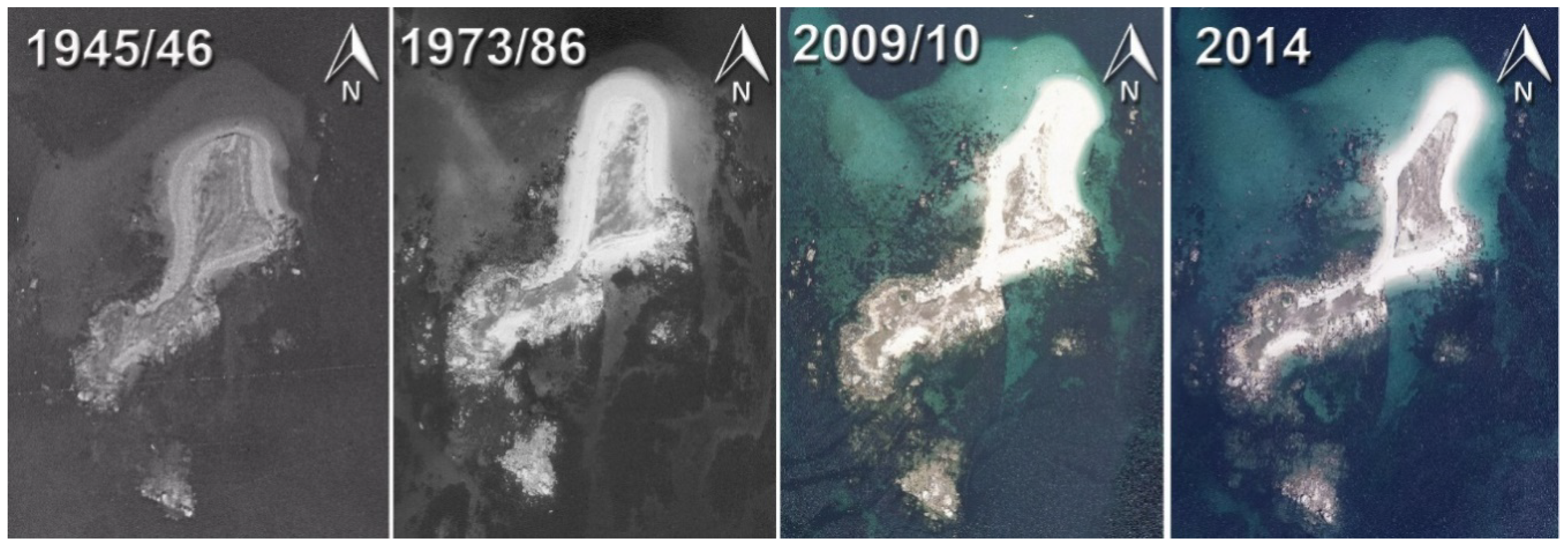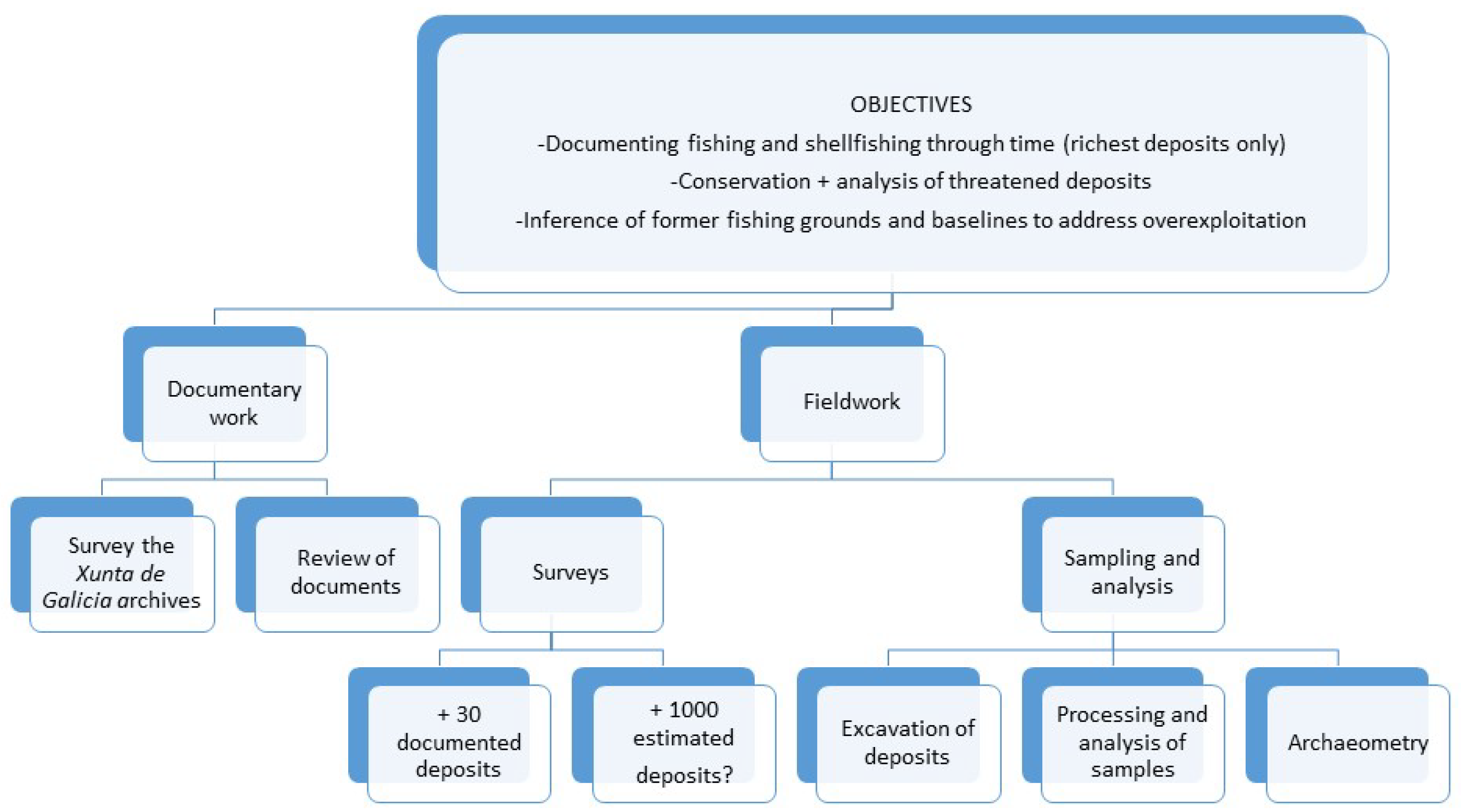Fish- and Shellmiddens from Galicia (Northwest Spain): Reflections upon a Neglected Coastal Cultural Heritage from the Iberian Peninsula
Abstract
1. Introduction
2. Relevance of Midden Deposits in Galicia
3. Threats to the Galician Coastal Midden Heritage
3.1. Anthropic Agents
3.2. Natural Agents
4. A Long Historical Record of Midden Destruction
5. A Master Plan for the Future
- Documentary work: One first requirement is to carry out a systematic review of archaeological inventories and interim reports housed in the regional archives of the Dirección Xeral do Patrimonio da Xunta de Galicia (i.e., Galicia’s regional government), as well as documents from medieval, modern, and contemporaneous times in archives of all kinds (including personal libraries). This would allow us to locate key spots linked with the exploitation of the marine realm. The deliverable from this effort should be a detailed and comprehensive map of Galician midden locations to carry out the fieldwork.
- Simultaneously, we need to provide guidelines to the administration to ensure, on the one hand, a prompt response once sites are located, as well as appropriate ways to excavate, curate, transport, and eventually study midden materials.
- Fieldwork: This part will require an intensive survey of the Galician littoral, perhaps the most urgent aspect of our proposal at this moment. Previous gathering of data from the local inhabitants would be necessary. Surveys should not just provide lists of sites for any given region but also set up a priority list of actions for each site. To this end, it would be necessary to generate a unitary scale where the threats faced by each deposit, including coastal exposition, size, and the specific kinds of anthropic and natural risks, could integrate into a specific value set within a previously defined scale. Given that survey teams would be required to work for days on transects of several kilometers, a substantial task of the master plan implies training programs before people can set off for the field.
6. Conclusions
Author Contributions
Funding
Acknowledgments
Conflicts of Interest
References
- A.G. El mar, principal amenaza de las mámoas de Areoso. Faro de Vigo, June 28.
- Acuña Castroviejo, Fernando. 1996. Historiografía e investigación de la Cultura Castrexa en Galicia. In A Cultura Castrexa Galega a Debate. Edition Coordinated by José Manuel Hidalgo Cuñarro. Tui: Instituto de Estudios Tudenses, pp. 25–39. [Google Scholar]
- Alonso, José. 2016. Los temporales causan estragos en yacimientos arqueológicos costeros de Barreiros y Ribadeo. La Voz de Galicia, February 23. [Google Scholar]
- Anderson, David G., Thaddeus G. Bissett, Stephen J. Yerka, Joshua J. Wells, Eric C. Kansa, Sarah W. Kansa, Kelsey Noack Myers, R. Carl DeMuth, and Devin A. White. 2017. Sea-level rise and archaeological site destruction: An example from the southeastern United States using DINAA (Digital Index of North American Archaeology). PLoS ONE 12: e0188142. [Google Scholar] [CrossRef] [PubMed]
- Ashmore, Patrick. 1994. Archaeology and the Coastal Erosion Zone: Toward a Historic Scotland Policy. Edinburgh: Historic Scotland. [Google Scholar]
- Ballesteros-Arias, Paula. 2009. O Aproveitamento do mar a o longo do tempo, a documentación do xacemento romano de Canexol (Illa de Ons, Bueu). Cuadernos de Estudios Gallegos 56: 67–90. [Google Scholar] [CrossRef][Green Version]
- Ballesteros-Arias, Paula, Alejandro Güimil-Fariña, and Elías López-Romero. 2013. Estudio arqueolóxico do Parque Nacional Marítimo-Terrestre das Illas Atlánticas de Galicia. Prospección superficial e vulnerabilidade. Capa 33, Cuadernos de Arqueoloxía e Patrimonio. Madrid: CSIC-INCIPIT. [Google Scholar]
- Bejeja-García, Víctor. 2015. El marisqueo en el noroeste de la Península Ibérica durante la Edad del Hierro y la Época Romana. Ph.D. Thesis, Universidad de León, León, Spain. [Google Scholar]
- Bejega-García, Víctor, Eduardo González Gómez de Agüero, and Carlos Fernández Rodríguez. 2011. Pesca y marisqueo en el yacimiento de Area (Viveiro, Lugo). Férvedes 7: 255–63. [Google Scholar]
- Bell, Trevor, and Christina Robinson. 2014–2019. CARRA Coastal Archaeological Resources Risk Assesment. Available online: https://carra-nl.com/ (accessed on 12 February 2019).
- Blanco-Chao, Ramón, Manuela Costa-Casais, José Manuel Rey-García, and Xosé Ignacio Vilaseco Vázquez. 2015. Erosión costera en yacimientos arqueológicos: Guidoiro Areoso, Ría de Arousa, Galicia. Geo-Temas 15: 1–4. [Google Scholar]
- Bouza, Luis Felipe. 2014. Los temporales destapan en el litoral nuevos restos arqueológicos. El Progreso, March 20. [Google Scholar]
- Calvo y Sánchez, Ignacio. 1914. Exploraciones arqueológicas. Citanias gallegas. Revista de Archivos, Bibliotecas y Museos XXXI: 1–15. [Google Scholar]
- Calvo y Sánchez, Ignacio. 1920. Monte de Santa Tecla. La Guardia (Pontevedra). Exploraciones arqueológicas verificadas en los años 1914 a 1920. Vigo: Revista de Archivos, Bibliotecas y Museos. [Google Scholar]
- Calvo y Sánchez, Ignacio. 1924. Monte de Santa Tecla en Galicia. Memoria de los trabajos realizados en 1922–23. Memoria no. 62. Edición especial de la “Sociedad Pro-Monte”. La Guardia: Junta Superior de Excavaciones y Antigüedades. [Google Scholar]
- Daire, Marie-Yvane, Elias Lopez-Romero, Jean-Noël Proust, Hervé Regnauld, Soazig Pian, and Benheng Shi. 2012. Coastal Changes and Cultural Heritage (1): Assessment of the Vulnerability of the Coastal Heritage in Western France. The Journal of Island and Coastal Archaeology 7: 168–82. [Google Scholar] [CrossRef]
- Domínguez Fontela, Juan. 1925. La estación paleolítica de La Guardia. Boletín Arqueológico de la Comisión Provincial de Monumentos Históricos y Artísticos de Orense 160: 241–44. [Google Scholar]
- English Heritage. 1997. England’s Coastal Heritage: A Statement on the Management of Coastal Archaeology. London: English Heritage. [Google Scholar]
- Erlandson, Jon M. 2008. Racing a rising tide: Global warming, rising seas and the erosion of Human History. Journal of Island and Coastal Archaeology 3: 167–69. [Google Scholar] [CrossRef]
- Erlandson, Jon M., and Scott M. Fitzpatrick. 2006. Oceans, islands, and coasts: Current perspectives on the role of the sea in human prehistory. Journal of Island & Coastal Archaeology 1: 5–32. [Google Scholar]
- Esmoris Recamán, Francisco. 1923. Recuerdos históricos de la villa de Finisterre. El Ideal Gallego, November 8. [Google Scholar]
- Fernández Gil y Casal, Juan. 1916. Apuntes arqueológicos. Boletín de la Academia de la Historia LXVIII: 29–46. [Google Scholar]
- Fernández Macho, Javier, Carmen Gallastegui Zulaica, and Pilar Gonzalez Casimiro. 2006. Medición de impactos económicos a partir de una matriz de contabilidad social: El sector pesquero en Galicia. Revista Española de Estudios Agrosociales y Pesqueros 212: 41–79. [Google Scholar]
- Fernández Rodríguez, Carlos. 2000. Los macromamíferos en los yacimientos arqueológicos del Noroeste peninsular: Un estudio económico. Ph.D. Thesis, Tesis Doctorales de la Universidad de Santiago de Compostela, Edición en cd-rom. Universidade de Santiago de Compostela, Santiago de Compostela, Spain. [Google Scholar]
- Fernández Rodríguez, Carlos, Eduardo González Gómez de Agüero, and Víctor Bejega García. 2008. Estudio del conchero del Castro de Punta Atalaia (San Cibrao, Lugo). Férvedes 5: 43–52. [Google Scholar]
- Fernández Rodríguez, Carlos, Víctor Bejega García, and Eduardo González Gómez de Agüero. 2014a. Shellfish gathering during the Iron Age and Roman Times in the northwest of the Iberian Peninsula. In Archaeomalacology: Shells in the Archaeological Record. Edited by Katherine Szabó, Catherine Dupong, Vesna Dimitrijević, Luis Gómez Gastélum and Nathalie Serrand. BAR International Series 2666; Oxford: Archaeopress, pp. 135–45. ISBN 978-1-40-731308-5. [Google Scholar]
- Fernández Rodríguez, Carlos, Víctor Bejega García, Eduardo González Gómez de Agüero, and Natividad Fuertes Prieto. 2014b. Púrpuras del Finisterre: El registro de murícidos en época romana en el noroeste peninsular. In Moluscos y púrpura en contextos arqueológicos atlántico-mediterráneos. Nuevos datos y reflexiones en clave de proceso históico. Edited by Juan Jesús Cantillo Darío Bernal and José Ramos. Cádiz: Actas Historia y Arte, Universidad de Cádiz, pp. 319–28. ISBN 978-8-49-828475-1. [Google Scholar]
- Fernández Rodríguez, Carlos, María Natividad Fuertes Prieto, Eduardo Ramil Rego, Víctor Bejega García, and Eduardo González Gómez de Agüero. 2015. A Cabana (Barreiros, Lugo): Primeros datos de un conchero purpurino en la costa cantábrica. Férvedes 8: 85–94. [Google Scholar]
- Ferreira Priegue, Elisa María. 1988. Galicia en el comercio marítimo medieval. Ph.D. Thesis, Universidad de Santiago de Compostela, Santiago de Compostela, Spain. [Google Scholar]
- Ferreira Priegue, Elisa María. 2009. Pesca y economía regional en Galicia. In La pesca en la Edad Media. Edited by Sociedad Española de Estudios Medievales. Madrid: Monografías de la Sociedad Española de Estudios Medievales, Volume 1, pp. 145–66. [Google Scholar]
- Flatman, Joe. 2009. A climate of fear: Recent British policy and management of coastal heritage. Public Archaeology 8: 3–19. [Google Scholar] [CrossRef]
- Francés, Guillermo, Irene Alejo, Patricia Bernárdez, Paula Diz, Raquel González Álvarez, Joan Grimalt, Angel Mena, Miguel Angel Nombela, Leopoldo Pena, Marta Pérez Arlucea, and et al. 2009. Marco climático mariño de Galicia na era preindustrial: Variabilidade climática natural a escala milenaria e submilenaria. In Evidencias e impactos do cambio climático en Galicia. Edited by Vicente Pérez Muñuzuri, Marisa Fernández Cañamero and José Luis Gómez Gesteira. Vigo: Xunta de Galicia, Consellería de Medio Ambiente e Desenvolvemento Sostible, pp. 249–70. [Google Scholar]
- Gómez-Pazo, Alejandro, and Augusto Pérez-Alberti. 2017. Vulnerabilidad de las costas de Galicia ante los temporales marinos en el contexto del cambio global. Sémata, Ciencias Sociais e Humanidades 29: 117–42. [Google Scholar]
- González, Pablo. 2005. La superficie construida en la costa gallega supera la media Española. La Voz de Galicia, November 5. [Google Scholar]
- González Gómez de Agüero, Eduardo. 2014. La ictiofauna de los yacimientos arqueológicos del noroeste de la Península Ibérica. León: Área de Publicaciones de la Universidad de León. Serie Tesis Doctorales; 431p, ISBN 978-84-97-73688-6. [Google Scholar]
- Graham, Ellie, Joanna Hambly, and Tom Dawson. 2017. Learning from Loss: Eroding Coastal Heritage in Scotland. Humanities 6: 87. [Google Scholar] [CrossRef]
- Guidoiro Dixital. 2018. Guidoiro Areoso: Erosión litoral e arqueoloxía. Available online: https://guidoirodixital.wordpress.com/ (accessed on 3 March 2018).
- Gutiérrez-Zugasti, Igor, Emma Tong, Asier García-Escárzaga, David Cuenca-Solana, Geoffrey N. Bailey, and Manuel R. González-Morales. 2016. Collection and consumption of echinoderms and crustaceans at the Mesolithic shell midden site of El Mazo (northern Iberia): Opportunistic behaviour or a social strategy? Quaternary International 407: 118–30. [Google Scholar] [CrossRef]
- Instituto Geográfico Nacional. 2004–2018. Fototeca Nacional, Plan Nacional de Ortofotografía Aérea (PNOA). Data Retrieved September 2017. Available online: http://pnoa.ign.es/ (accessed on 15 March 2018).
- Llorente Rodríguez, Laura, and Arturo Morales Muñiz. 2015. Los moluscos del pozo-depósito de Tabacalera. In La Fábrica de Tabacos de Gijón. Arqueología e Historia de un espacio milenario. Edited by Carmen Fernández Ochoa, Almudena Orejas Saco del Valle, Paloma García Díaz and Fernando Gil Sendino. Gijón: Ayuntamiento de Gijón, pp. 260–65. ISBN 978-8-48-946671-5. [Google Scholar]
- López-Romero, Elías, Patricia Mañana-Borrazás, Marie-Yvane Daire, and Alejandro Güimil-Fariña. 2014. The eSCOPES Project: preservation by record and monitoring at-risk coastal archaeological sites on the European Atlantic façade. Antiquity, Project Gallery 88: 339. [Google Scholar]
- López-Romero, Elías, María Pilar Prieto Martínez, Alejandro Güimil-Fariña, Jose Manuel Rey García, Patricia Mañana-Borrazás, X. Ignacio Vilaseco Vázquez, and Carlos Otero Vilariño. 2015. Ocupación humana y monumentalidad durante la Prehistoria Reciente en el islote de Guidoiro Areoso (Ría de Arousa, Pontevedra). Investigaciones en el marco de las dinámicas litorales atlánticas actuales. Trabajos de Prehistoria 72: 353–71. [Google Scholar] [CrossRef]
- López-Romero, Elías, Xosé Ignacio Vilaseco Vázquez, Patricia Mañana Borrazas, and Alejandro Güimil Fariña. 2017. Recovering information from eroding and destroyed coastal archaeological sites: A crowdsourcing initiative in Northwest Iberia. In Public Archaeology and Climate Change. Edited by Tom Dawson, Courtney Nimura, EliasLópez-Romero and Marie-Yvane Daire. Oxford and Philadelphia: Oxbow Books, pp. 72–80. ISBN 978-1-78-570705-6. [Google Scholar]
- Lorenzo, Francisco, Angela Alonso, and José Luis Pagés. 2003. Evolución y erosión comparada de tres sistemas playa/flecha en las Rías de Ortigueira, O Barquero y Viveiro (Galicia, España). Revista Cuaternario y Geomorfología 17: 75–89. [Google Scholar]
- Lourido, Francisco Calo. 1997. A Cultura Castrexa. Historia de Galicia 3, 2nd ed. Vigo: Edicións A Nosa Terra. ISBN 978-8-489-13871-1. [Google Scholar]
- Marcos, Pilar, Sara del Río, and Julio Barea. 2010. Destrucción a toda costa 2010. Informe de Greenpeace sobre la situación del litoral español. Greenpeace España. Available online: http://www.greenpeace.org/espana/Global/espana/report/other/100709-04.pdf (accessed on 4 March 2018).
- Morales-Muñiz, Arturo, Eduardo González-Gómez de Agüero, Carlos Fernández-Rodríguez, Fran Saborido Rey, Laura Llorente-Rodriguez, Begoña López-Arias, and Eufrasia Roselló-Izquierdo. 2018. Hindcasting to forecast. An archaeobiological approach to the European hake (Merluccius merluccius, Linnaeus 1758) fishery: Iberia and beyond. Regional Studies in Marine Science 21: 21–29. [Google Scholar] [CrossRef]
- Murguía, Manuel. 1888. Galicia. Barcelona: Daniel Cortezo. [Google Scholar]
- Ortí, Antonio. 2016. Las grandes olas aumentan de tamaño. Faro de Vigo, August 13. [Google Scholar]
- Pagés Valcarlos, José Luis. 2000. Origen y evolución geomorfológica de las Rías Atlánticas de Galicia. Revista de la Sociedad Geológica de España 13: 393–403. [Google Scholar]
- Pickard, Catriona, and Clive Bonsall. 2004. Deep-sea fishing in the European Mesolithic: Fact or fiction? European Journal of Archaeology 7: 273–90. [Google Scholar] [CrossRef]
- Ramil Soneira, José María. 1973. Paradero de Reiro. Cuadernos de Estudios Gallegos XXVIII: 23–31. [Google Scholar]
- Reeder-Myers, Leslie A. 2015. Cultural Heritage at Risk in the Twenty-First Century: A Vulnerability Assessment of Coastal Archaeological Sites in the United States. The Journal of Island and Coastal Archaeology 10: 436–45. [Google Scholar] [CrossRef]
- Rey-García, José Manuel, and Xosé Ignacio Vilaseco-Vázquez. 2012. Guidoiro Areoso. Megalithic cemetery and prehistoric settlement in the Ría de Arousa (Galicia, NW Spain). In Environmental Changes and Human Interaction along the Western Atlantic Edge. Edited by António Campar Almeida, Ana Maria dos Santos Bettencourt, Delminda Moura, Sérgio Monteiro-Rodrígues and María Isabel Caetano Alves. Coimbra: APEQ, CITCEM, CEGOT, CGUP, CCT, pp. 243–58. ISBN 978-9-89-971401-4. [Google Scholar]
- Rosón, Gabriel, José Manuel Cabanas, Fiz Fernández Pérez, José Luis Herrera, Manuel Ruiz-Villarreal, Carmen González Castro, Silvia Piedracoba, and Xosé Antón Álvarez-Salgado. 2009. Evidencias do cambio climático na hidrografía e a dinámica das rías e da plataforma galega. In Evidencias e impactos do cambio climático en Galicia. La Coruña: Xunta de Galicia, pp. 287–302. ISBN 978-8-44-53472-9. [Google Scholar]
- SCAPE TRUST. 2019 Scotland’s Coastal Heritage at Risk. Available online: http://www.scapetrust.org/ (accessed on 17 April 2019).
- Serantes, Salvador. 2014. Los temporales descubren más restos arqueológicos en Area. Viveiro. La Voz de Galicia, February 11. [Google Scholar]
- Souto, Javier, Vicente Lustres-Pérez, and Eugenio Fernández-Pulpeiro. 2008. Nuevos datos sobre la presencia del Molusco Gasterópodo Stramonita haemastoma (Linnaeus, 1766) en las costas gallegas. Nova Acta Científica Compostelana (Bioloxía) 17: 97–104. [Google Scholar]



| PERIOD | Montealegre | A Lanzada | Muiño do Vento | O Achadizo | |
|---|---|---|---|---|---|
| IRON AGE | NISP | 7035 | 4668 | 574 | 1324 |
| % FISH | 2% | 6.5% | 12% | 5.5% | |
| Punta Atalaia | A Cabana | Adro Vello | Brigantium | ||
| ROMAN | NISP | 15,931 | 1176 | 2013 | 224 |
| % FISH | 16.5% | 1.7% | 100% | 32% | |
| Punta Atalaia | Area | Taramancos | Castelo da Rocha | ||
| MEDIEVAL | NISP | 1198 | 2514 | 1410 | 1075 |
| % FISH | 84.5% | 74% | 37% | 94.5% |
© 2019 by the authors. Licensee MDPI, Basel, Switzerland. This article is an open access article distributed under the terms and conditions of the Creative Commons Attribution (CC BY) license (http://creativecommons.org/licenses/by/4.0/).
Share and Cite
de Agüero, E.G.-G.; Fernández-Rodríguez, C.; Roselló-Izquierdo, E.; Llorente-Rodriguez, L.; Bejega-García, V.; Fuertes-Prieto, N.; Morales-Muñiz, A. Fish- and Shellmiddens from Galicia (Northwest Spain): Reflections upon a Neglected Coastal Cultural Heritage from the Iberian Peninsula. Humanities 2019, 8, 85. https://doi.org/10.3390/h8020085
de Agüero EG-G, Fernández-Rodríguez C, Roselló-Izquierdo E, Llorente-Rodriguez L, Bejega-García V, Fuertes-Prieto N, Morales-Muñiz A. Fish- and Shellmiddens from Galicia (Northwest Spain): Reflections upon a Neglected Coastal Cultural Heritage from the Iberian Peninsula. Humanities. 2019; 8(2):85. https://doi.org/10.3390/h8020085
Chicago/Turabian Stylede Agüero, Eduardo González-Gómez, Carlos Fernández-Rodríguez, Eufrasia Roselló-Izquierdo, Laura Llorente-Rodriguez, Víctor Bejega-García, Natividad Fuertes-Prieto, and Arturo Morales-Muñiz. 2019. "Fish- and Shellmiddens from Galicia (Northwest Spain): Reflections upon a Neglected Coastal Cultural Heritage from the Iberian Peninsula" Humanities 8, no. 2: 85. https://doi.org/10.3390/h8020085
APA Stylede Agüero, E. G.-G., Fernández-Rodríguez, C., Roselló-Izquierdo, E., Llorente-Rodriguez, L., Bejega-García, V., Fuertes-Prieto, N., & Morales-Muñiz, A. (2019). Fish- and Shellmiddens from Galicia (Northwest Spain): Reflections upon a Neglected Coastal Cultural Heritage from the Iberian Peninsula. Humanities, 8(2), 85. https://doi.org/10.3390/h8020085




